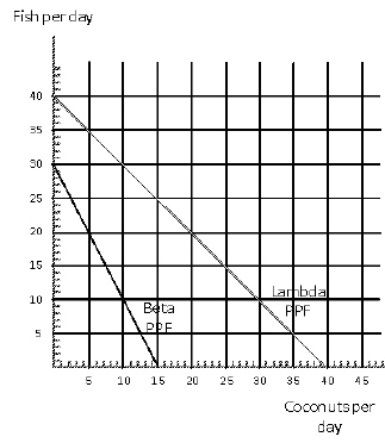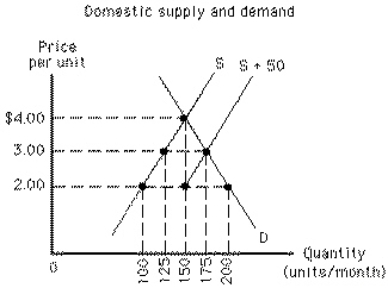A) low productivity
B) too much saving
C) unstable business climate
D) poor education and training
E) lack of adequate physical capital supplied to labor
G) C) and D)
Correct Answer

verified
Correct Answer
verified
Multiple Choice
A country will import a good only if
A) there is excess domestic quantity supplied at the world price
B) domestic quantity supplied is greater than world quantity supplied
C) domestic quantity demanded is less than world quantity demanded
D) domestic quantity demanded is zero at the world price
E) excess quantity demanded is positive at the world price
G) A) and C)
Correct Answer

verified
Correct Answer
verified
Multiple Choice
A tax on imports equal to a percentage of the cost of those imports is known as
A) a specific tariff
B) an ad valorem tariff
C) a tax on luxury goods only
D) an effective quota
E) an ad valorem quota
G) D) and E)
Correct Answer

verified
Correct Answer
verified
Multiple Choice
Exhibit 19-1  Exhibit 19-1 shows the production possibilities frontiers for the countries of Lambda and Beta for fish and coconuts.What is the opportunity cost of a coconut in Lambda?
Exhibit 19-1 shows the production possibilities frontiers for the countries of Lambda and Beta for fish and coconuts.What is the opportunity cost of a coconut in Lambda?
A) 1/2 fish
B) 1 fish
C) 2 fish
D) 21/2 fish
E) cannot tell from the information provided
G) None of the above
Correct Answer

verified
Correct Answer
verified
Multiple Choice
The General Agreement on Tariffs and Trade (GATT) was established in
A) 1870 to protect U.S.industries and decrease world trade
B) 1921 to manage legal and accounting requirements for U.S.tariffs and quotas
C) 1947 to reduce trade restrictions among 23 countries
D) 1973 to increase trade restrictions, after OPEC significantly raised oil prices
E) 1990 to create a common market
G) A) and E)
Correct Answer

verified
Correct Answer
verified
True/False
Under a tariff, the domestic government gains revenue, but under an import quota it does not, unless it sells the quota rights.
B) False
Correct Answer

verified
Correct Answer
verified
Multiple Choice
Which of the following factors is the most significant in determining the pattern of international trade?
A) absolute advantage
B) diplomatic expertise
C) comparative advantage
D) overpowering military strength
E) a country's size relative to another country's
G) B) and D)
Correct Answer

verified
Correct Answer
verified
Multiple Choice
Which of the following is not a type of trade restriction?
A) low-interest loans to foreign buyers
B) export subsidies for domestic firms
C) domestic content requirements
D) restrictive health and safety standards
E) economies of scale
G) A) and C)
Correct Answer

verified
Correct Answer
verified
Multiple Choice
Which of the following is not a problem with trade restrictions?
A) the high cost of rent-seeking activities such as lobbying
B) the high cost of enforcement
C) the unintended effects on related industries
D) the inability to save U.S.jobs in the short run in industries that compete with imports
E) the possibility of retaliation
G) B) and E)
Correct Answer

verified
Correct Answer
verified
Multiple Choice
Which country is the United States' largest trading partner?
A) Canada
B) Japan
C) Great Britain
D) Mexico
E) South Korea
G) B) and C)
Correct Answer

verified
Correct Answer
verified
True/False
International trade between countries typically produces a winner and a loser.Generally, it is the economically more advanced country that gains at the expense of the less developed nation.
B) False
Correct Answer

verified
Correct Answer
verified
Multiple Choice
Tina Makumbi imports sesame oil from Ethiopia and sells to a market that has a downward sloping demand curve.The demand curve indicates that some consumers are willing to pay $1.50 or more per pound for the first few pounds, but every consumer gets to buy at the market clearing price of $0.50 per pound.The difference between the most that consumers would pay and the actual amount they do pay is called
A) exporter surplus
B) trade balance
C) producer surplus
D) consumer equilibrium
E) consumer surplus
G) B) and E)
Correct Answer

verified
Correct Answer
verified
Multiple Choice
Exhibit 19-8  If the country in Exhibit 19-8 is initially trading without restrictions at a world price of $2.00 and an import quota of 50 units per month is enacted,
If the country in Exhibit 19-8 is initially trading without restrictions at a world price of $2.00 and an import quota of 50 units per month is enacted,
A) imports will not change
B) imports will increase from 25 to 50 units per month
C) domestic production will increase from 100 to 175 units per month
D) domestic production will increase from 100 to 125 units per month
E) domestic production will increase from 100 to 150 units per month
G) A) and C)
Correct Answer

verified
Correct Answer
verified
Multiple Choice
Exhibit 19-4  In Exhibit 19-4, if the world price of tulips is $1 and there are no trade restrictions, The Netherlands will
In Exhibit 19-4, if the world price of tulips is $1 and there are no trade restrictions, The Netherlands will
A) produce 7, 000, consume 10, 000, and export 3, 000 tulips
B) produce 10, 000 and consume 10, 000 tulips
C) produce no tulips
D) import all of the tulips that it consumes
E) consume all of the tulips that it produces
G) B) and E)
Correct Answer

verified
Correct Answer
verified
Multiple Choice
Absolute advantage
A) is the same as comparative advantage
B) implies autarky
C) means that countries of the same size have the same opportunity cost of producing both goods
D) means that a country can produce more of two goods than another country can
E) means that a country can produce less of two goods than another country can
G) C) and D)
Correct Answer

verified
Correct Answer
verified
Multiple Choice
A nation's consumption possibilities frontier is
A) always the same as its production possibilities frontier
B) never the same as its production possibilities frontier
C) the same as its production possibilities frontier only if there is advantageous trade
D) the same as its production possibilities frontier only if there is no international trade
E) usually lower than its production possibilities frontier
G) B) and E)
Correct Answer

verified
Correct Answer
verified
Multiple Choice
An import quota is a
A) legal limit on the quantity of a good that can be imported per year
B) legal requirement that a specified percentage of a final good's value must be produced domestically
C) legal requirement that exports to a certain country must exceed a specified value before that country's product may be imported
D) percentage tax on an imported product
E) lump-sum tax on an imported product
G) B) and E)
Correct Answer

verified
Correct Answer
verified
Multiple Choice
Revenue from a(n) __________ goes to the U.S.government while revenue from a(n) __________ goes to whomever secures the right to sell foreign goods in the U.S.market.
A) export subsidy, quota
B) tariff, quota
C) domestic content requirement, low-interest loan
D) tariff, export subsidy
E) quota, tariff
G) A) and C)
Correct Answer

verified
Correct Answer
verified
Multiple Choice
If production is subject to economies of scale,
A) countries can gain from trade if each nation specializes
B) one country will develop an absolute advantage in the production of all goods
C) higher output levels result in higher average production costs
D) one country will develop a comparative advantage in the production of all goods
E) countries cannot gain from trade
G) C) and D)
Correct Answer

verified
Correct Answer
verified
Multiple Choice
For each watch Denmark produces, it gives up the opportunity to make 50 pounds of cheese.Germany can produce one watch for every 100 pounds of cheese it produces.Which of the following is true with regard to opportunity costs in the two countries?
A) The opportunity cost of producing watches is higher in Denmark.
B) The opportunity cost of producing cheese is higher in Denmark.
C) The opportunity cost of producing cheese is identical in both countries.
D) It is impossible to compare opportunity costs because the two countries use different currencies.
E) In both countries combined, the opportunity cost of one watch is 150 pounds of cheese.
G) None of the above
Correct Answer

verified
Correct Answer
verified
Showing 81 - 100 of 172
Related Exams